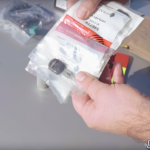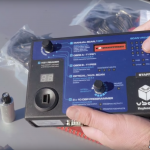VATS stands for Vehicle Anti Theft System. Lots of people refer to this type of key, as a ” computer Chip key”. This key or “Chip” has nothing to do with a computer, nor is it a chip. But because of the popularity of calling it a computer chip key, so will we. So that we don’t confuse. The black chip on the blade of the key is actually a resister. GM first started using the Vats key in 1986 on the Corvettes, then some of the Cadillac’s, etc. GM uses 15 different resistors in their vats keys. Just looking at the keys you can’t tell the difference.
How does the Vats System work?
Each vats key has its own unique cuts on the key to operate the lock. But the cuts alone will not allow the car to crank. This is called a mechanical key. Each car has a Vats module (Brain) under the dash that communicates to the starter, fuel pump, and the ignition lock. Each vats module is randomly given a # (value) from the manufacturer. When the proper mechanical keys, with the proper vats chip (resistor value) turns the ignition lock, the vats module reads the chip on the key. If it is the correct chip, the vats module will tell the starter and the fuel pump to operate. If the wrong chip is read, the vats module will tell starter and the fuel pump to shut down.
VATS (Vehicle Anti Theft System) was introduced by GM on the 1986 Corvette because the Corvette had become the number one target for car thieves. Corvette thefts dropped so impressively after VATS was implemented that GM expanded the system in 1988 to the Camaro, Firebird, and Cadillac Seville. VATS was standard equipment on all Cadillac vehicles and on many other Chevrolet, Pontiac, Buick, and Oldsmobile vehicles.
Each VATS key has a resistor embedded within the key-blade, and each resistor has 1 of 15 possible values. Decoding a VATS key is simple but it requires that you use an ohm meter.
VATS keys have a resistor embedded in the key blade with metal prongs protruding out of each side of the key blade. In order to read the resistance of the resistor in the key blade, place one lead of the ohm meter on one metal prong, and the other lead on the other metal prong, opposite, on the other side of the key blade. With the leads in their proper position, a resistance value can be read from the ohm meter.
The black plastic pellet in the blade of the key contains a simple resistor, not a computer. There are 15 resistor values in the VATS system for 6 cut and 10 cut GM Keys.
Tamper: This mode happens when the wrong resister key or mechanical key for the vehicle is cranked and the resistance value as seen by the module is not the same as the value stored in the module. When this happens the module shuts down and the car will not start for the 4 minute “time-out”. The security light will also illuminate for the 4 minutes. The Start Enable Relay will not energize and the Fuel Enable signal will not be sent. After the “time-out” and the correct key and resistor is inserted the car will start.


We can come out to your location if you are unable to come to us. Our Mr. Locksmith auto locksmith will arrive in a marked vehicle and carry identification.
- Lost Car keys replaced
- Lost Truck Keys replaced
- Keys are locked inside the car
- Car ignition key replacement and repairs
- Emergency Locked trunk opening
- Auto lockout available 24 hours
- Car locks & Ignition unlocking
- On-site key made if you lost car keys
- Broken auto ignition key extraction
- Transponder chip key duplication
- VATS keys replacement and repairs
- Chipped Key Duplication
- Honda Ignition Jammed? Call Mr. Locksmith Automotive
If you need an extra Car, Truck or Motorcycle key call Randy at Mr. Locksmith Automotive (604) 259-7617 or email [email protected]
Mr. Locksmith Vancouver
Vancouver Locksmith Main: (604) 239-0882
Downtown Vancouver Locksmith: (604) 262-1907
Downtown Vancouver Keystore: (604) 669-8008
Mr. Locksmith Automotive: (604) 259-7617
For On-line and Hands-on Locksmith Training Dates and Cities near you by Terry Whin-Yates for Beginners, Intermediate, Advanced Locksmithing as well as my Covert Methods of Entry, Non-destructive Methods of Entry and to purchase the Famous “Dumb Key Force Tool” that opens Smart Key locks in seconds go to Mr. Locksmith Training
For Locksmith Franchise and Licensing Opportunities go to http://mrlocksmith.com/locksmithfranchise-opportunities/
For On-line and Hands-on Locksmith Training Dates and Cities near you for Beginners, Intermediate, Advanced Locksmithing as well as my Covert Methods of Entry, Non-destructive Methods of Entry and to purchase the Famous “Dumb Key Force Tool” that opens Smart Key locks in seconds go to Mr. Locksmith Training.
For Mr. Locksmith™ Franchise and Licensing Opportunities go to http://mrlocksmith.com/locksmithfranchise-opportunities/.
